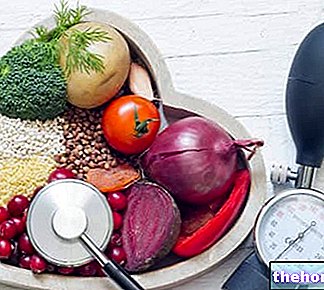A precious ally in the kitchen
The pressure cooker proves to be a useful ally in the kitchen, friend - above all - of low-calorie diets seasoned with a touch of practicality. In fact, it allows you to cook food "steamed" at a pressure higher than the ambient pressure, significantly reducing normal cooking times.
The pressure cooker is very similar to traditional cookware, with two main differences: the thicker walls, made of stainless steel or heavy aluminum, and the lid which guarantees an airtight seal and the possible release of excess vapors through the special valve. In the lid there is a rubber gasket that allows it to adhere perfectly to the edges of the pot, a device, usually a metal lever, for hermetic closure, and a couple of valves to let out the excess steam once the maximum pressure is reached. .
Pressure cooker how does it work?
The principle of operation of the pressure cooker is quite simple; thanks to the presence of a hermetically sealed lid, it retains a large part of the water particles normally dispersed by evaporation, which stratify by exerting a certain pressure on the cooking liquid; this pressure, in fact, can ideally be imagined as a piston that pushes the cooking liquid downwards, opposing its boiling because the water molecules have more difficulty in coming out of the liquid in the form of vapor. Consequently, inside this pot the water compressed by the steam reaches the " boiling no longer at 100 ° C but at 120-130 ° C, significantly shortening the cooking times of food; if we want it is the exact opposite of what happens at high ground, where - due to the lower atmospheric pressure (lower layer of air particles pressing on the liquid) - the water reaches boiling at a lower temperature than the level of the sea. It should be noted that, regardless of the atmospheric pressure, once boiling has been reached, the water maintains its temperature constant even supplying additional heat to the system.

Pressure cooker: advantages
- Particularly suitable for foods that require prolonged cooking, such as legumes and cereals, the pressure cooker allows you to significantly speed up this phase, saving time, effort and energy, useful not only for home economics but also for the environment ( fuel is saved both to bring the water to a boil and to keep it in this state). In general, in a pressure cooker, foods cook in less than half or even a third of the time. Furthermore, those who choose the pressure cooker entrust it with the burden of cooking, since it does not require any attention or supervision from the cook, an element that translates into a disadvantage for those who, during cooking, want to carefully check what happens in The pressure cooker must in any case be checked in the first few minutes of cooking, in order to reduce the flame to a minimum when the valve begins to whistle.
- The pressure cooker allows a more homogeneous distribution of heat and allows you to keep the cooking liquids inside, together with the vapors, perfumes and aromas released by food. It is therefore a useful aid especially for boiled meats, stewed dishes and vegetables that are reluctant to cook in a short time.
- Through the special basket, it allows you to steam quickly, benefiting from all the advantages of this cooking method, especially in terms of health in preserving vitamins and minerals, which are destroyed in lower percentages than with long cooking.
- Since the dispersion of natural aromas is significantly lower, it is possible to reduce the amount of spices, salt and various condiments.
- When the cooking is quite advanced but not yet completed, according to experience, you can turn off the heat in order to find the food ready and still warm after a few hours.
- Cooking at high temperatures improves the digestibility of cereals and legumes, while - considering the shorter cooking time - it does not overly alter the thermolabile vitamins.
- In general, pressure cookers are equipped with a series of accessories to facilitate the cooking of various foods, such as steaming baskets, grills to reduce the boiled effect of the meat by preventing it from coming into contact with water, and a bowl for cooking. cook flans, timbales, creams, puddings and vegetables.
Pressure cooker: disadvantages
- Cost for the purchase higher than traditional pots.
- You can't control what's cooking in the pot, because of the lid, and it's therefore difficult to make sure that everything is going well; in this sense it is necessary to rely on the chronometer and on experience.
- In general, the cooking times with a pressure cooker are equivalent to one third of what is necessary to cook the same dish with traditional pots. If on the one hand this allows to significantly shorten cooking times - by the same principle - five minutes too long is equivalent to a quarter of an hour in the traditional pot, with the risk of overcooking the food.
- Due to the presence of steam inside, the pressure cooker is not suitable for lovers of full-bodied flavors, such as roasts. In fact, the pressure cooker neither browns nor heats; if necessary, those who want to give a certain browning to the food can pass them in a traditional pot over high heat before or after pressure cooking.
- Requires periodic maintenance.
Is the pressure cooker safe?
The safety of the pressure cooker is guaranteed by the special relief valve, a very simple and at the same time very important mechanism consisting of a small hole held closed by a carefully calibrated metal weight to ensure that, once a certain pressure has been reached inside the pot , is displaced by gases. In this way, the small hole is released giving vent to the excess steam, whose escape is witnessed by the typical hum and gurgling of the pot, indicating that the temperature has reached the ideal value and that it is necessary to reduce the power of the fire to a minimum. The relief valve therefore prevents the pressure cooker from turning into a sort of bomb, a danger that has made it the subject of completely unfounded urban legends, made up of explosions, destroyed walls, burned arms and so on.
In every pressure cooker there are two types of valves, the operating one and the safety one, calibrated to open at a higher pressure. The latter consists of a rubber stopper which is pushed away when the internal pressure becomes excessive, creating a further possibility of venting the steam.
To cook with the pressure cooker in complete safety it is essential to respect some simple rules:
- avoid inserting sealed containers and jars inside the pot, due to the risk of causing them to burst due to the high internal pressure.
- The diameter of the burners in the stove must be equal to or smaller than the bottom of the pan.
- Do not place the pressure cooker over the flame if it has not been previously filled with a minimum quantity of liquid: otherwise the food would burn.
- For pressure cooking it is not possible, under any circumstances, to cook dry but always with the addition of water to varying degrees depending on the quantity of food and the type of cooking desired (boiled, roasted, stewed, etc.). quantities of liquid required are greater for foods that tend to absorb a lot of water during cooking, and vice versa, but in any case considerably lower than those required by recipes in traditional pots. In any case, the pressure cooker should never be filled over three quarters of its capacity (including food), to prevent the boiling liquid or foam from coming into close contact with the relief valve, preventing its regular operation. In many pots there is a safety notch engraved inside, indicating the maximum filling level, including food. If you are cooking dishes that tend to swell such as rice, lentils, etc., fill the pressure cooker up to a maximum of 1/2 full.
- Avoid cooking foods in foil, then wrapped in an external casing of various kinds which could clog the valve and prevent it from working.
- Carefully read the instruction booklet attached to the pot, which generally includes a recipe book with the cooking times of the various foods, calculated from the moment the pot reaches operating temperature. The suggested cooking times are purely indicative and may vary depending on the amount of food and water inserted.
- When cooked, turn off the flame and wait a few moments before opening the pressure cooker; if possible, open the operating valve to allow the steam to escape; never remove the hermetic lid during boiling, to prevent the contents of the pot from overflowing due to the internal pressure. Eventually, when cooking is complete, it is possible to put the pot still closed under running water to cool it more quickly and condense the steam inside Follow the manufacturer's instructions.
Pressure cooker maintenance
- Wash the pot according to your habits, using the foresight to store it without a lid so as not to compromise its seal and avoid the stagnation of bad smells; if these develop, simply boil a little water and vinegar for a few minutes.
- The operating valve must be cleaned after each wash by unscrewing it and freeing it from accumulations of dirt; to ensure its efficiency, you must be able to blow freely into the hole. In the operation you can help yourself with a stiff brush and a little vinegar, or with a needle in case of important incrustations. The safety one requires less attention, just check at each washing that the rubber cap can be expelled without obstacles, so that too much dirt does not stagnate around it. Periodically it must be extracted, washed with running water and lubricated with edible oil to facilitate re-insertion.
- The rubber gaskets of the lid must be preserved from too aggressive detergents, which could damage them; the same goes for abrasive sponges, to be avoided because they could damage the inside of the pot. To increase the life of the seal, it is recommended to grease it with cooking grease, after each use, at least once a month. Unlike the pot, the lid and its seal should never be washed in the dishwasher. In general, it is not recommended to replace it every 400 hours of operation, since with the passage of time it tends to lose its hermetic capacity. More generally, the pressure cooker lid gasket will need to be changed as soon as you notice that it is no longer in perfect condition; in any case, if this were to be consumed or damaged there would be no danger, because the steam would not be retained by the pot and the pressure would simply not rise. Follow the manufacturer's instructions.
Pressure cooker: indicative cooking times





























